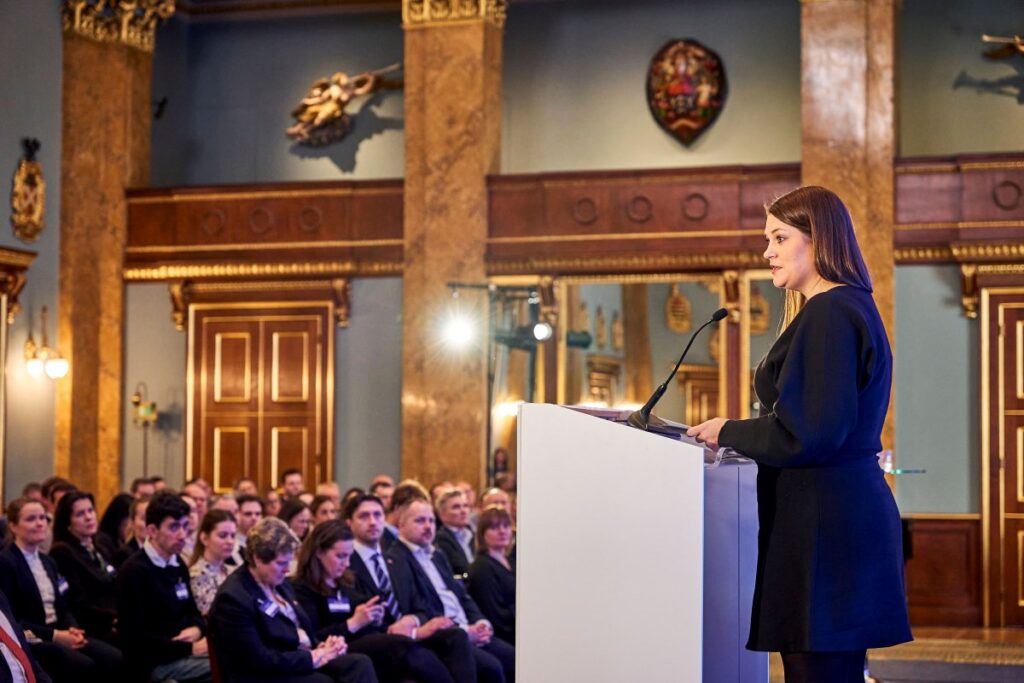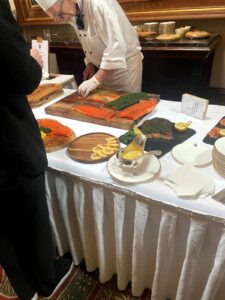Building up an appetite

How to persuade UK consumers to eat more seafood was a key issue at the Norway-UK Seafood Summit, reports Dr Martin Jaffa
At the end of February, Norway came to London in the form of the Norway-UK Seafood Summit, organised by the Norwegian Seafood Council (NSC). I have attended these summits since NSC decided to open an office in London several years ago and like those before it, the latest event was a lavish affair held in the historic surroundings of the Fishmongers’ Hall.
Unlike previous meetings, the emphasis moved away from the work of NSC to a more general overview of the seafood sector, with talks about the UK economic outlook; a view of seafood supply from a seafood analyst; the retail perspective on responsible sourcing: how seafood can win UK consumers; and finally the food trends of tomorrow.
The day began with presentations from the Norwegian Fisheries Minister Cecilie Myrseth and the UK Minister for Food, Farming and Fisheries Mark Spencer. This was not without controversy, as I believe will be reported elsewhere. Mr Spencer stressed to the Norwegians how easy it was for them to export salmon to the UK with the introduction of an electronic system to speed up transactions. Unfortunately, a similar system is not in place to help the Scottish salmon industry export their salmon abroad. He also said that whilst salmon requires certification, imports of cod and haddock do not. Sadly, both ministers departed Fishmonger’s Hall before they could face any questions.

Rt Hon Mark Spencer MP, UK Minister for Food, Farming and Fisheries, addresses delegates
Before he left, Mr Spencer also talked about aquaculture. He mentioned that a new aquaculture technology hub is to be established at the University of Stirling by 2025. He also said that exciting new aquaculture developments were soon to happen south of the border in Grimsby. Obviously, it doesn’t take much to get him excited!
I found two of the talks to be of the most interest and these are what I will focus on. One was given by an NSC analyst who talked about seafood supply. Whilst the facts and figures were certainly interesting, my perspective was that sometimes the data alone is not enough to provide a real understanding of what is happening in the seafood sector.
Much was made about how demand for fish and seafood has fallen, especially during the cost-of-living crisis. High prices have certainly suppressed consumption, but the implication was made that if prices fell, then demand would increase. This may be true, but it ignores an underlying trend of falling consumption as more and more consumers turn away from fish. This is mainly due to the fact that many consumers know very little about fish and don’t know what to do with it. Price is certainly a driver of fish consumption, but it is not the be-all and end-all.
Spencer said that UK consumers should eat more fish and seafood, but he didn’t say how this was to be achieved. In my opinion, it will be hard to turn around the consequences of many years of underinvestment in fish and seafood marketing. Despite their high spending power, I am not sure that even the NSC really know how to address the problem.
Interestingly, whilst salmon exports from Norway to the UK have fallen, imports of salmon from China and the USA have increased. However, what was not mentioned was that these imports are of Pacific salmon species and not farmed Atlantic salmon.
The analyst also highlighted that growth in salmon production is highest in Iceland at 63% compared to 1% in Norway. But 63% of little is much less than the 1% growth of Norway’s impressive salmon production.

Chef at the Norway-UK Seafood Summit
Consumer trends
The second presentation of interest came from market researchers Kantar World Panel and focused on the trends affecting consumers and the opportunities that these might open up for seafood producers. Members of the audience hoping for inspiration might have been a bit disappointed, however. The title “How can seafood win UK consumers in 2024?” failed to offer much hope except to say that evening meals or celebratory events would be where most opportunities lay. I don’t think that these “suggestions” come as any surprise, but the issue would be how to translate these opportunities into fish and seafood reality.
The wider trends presented were of more interest. Given the restrictions placed on the public by Covid, there has been a massive revival of out-of-home eating, despite the cost-of-living price pressures. This is not surprising as people seek an escape from the day-to-day struggle of dealing with rising prices. I am guilty of this myself, as the pleasures of eating out are definitely worth the cost. Yet out-of-home eating still has not returned to pre-pandemic levels. Whilst eating out has increased by 5% since 2022, it is still 5% down on 2019 figures.
By comparison, home consumption of fish and seafood is 2% down on 2022 figures, although up 4% on 2019. This shows the declines in consumption that have plagued the seafood sector for many years. Covid stay-at-home restrictions did bring about a significant increase in fish consumption at home, but in my view, these peaked long ago and consumption was already in decline again before the cost-of-living crisis hit.
I think it is a shame these summits don’t offer any real insight as to how consumption declines can be reversed.
I suspect that this is because no-one has any real, practical solutions.
Top trends
The last presentation of the day came from analysts The Food People, who discussed five of the top 10 food trends of 2024 and 2025. They did mention all 10, but I can’t say that any offered real hope for the fish and seafood sector, except one, which wasn’t discussed. This was a move towards ambient foods. I have always had a lot of time for products of this type, not least because they have a long shelf life and therefore can be viewed by consumers in a different way to fresh and chilled fish and seafood. Ambient is not an alternative to fresh and chilled but it is a way to expand the market, especially amongst those who are not traditional fish and seafood consumers.
Maybe ambient seafood might find its way onto next year’s summit programme, but then ambient seafood may be too far removed from the traditional markets to be included. I’ll let you know next year.
Call for a level playing field
Tavish Scott, Chief Executive of industry body Salmon Scotland, was also present at the summit. He commented afterwards on the remarks made by UK Fisheries Minister Mark Spencer, regarding electronic certification for seafood imports from Norway, a facility which is not reciprocated for UK seafood businesses exporting to Norway and the European Union.
Scott said: “We’ve been saying since Brexit that we need electronic systems to reduce the red tape for salmon farmers.
“So given this now happens for seafood imports from third countries like Norway, as highlighted by the Fisheries Minister, we’re surprised that this still hasn’t been sorted for exporters to the EU.
“International demand for Scottish salmon continues to increase and it’s vital for economic growth here at home that we remove barriers for key exporters like salmon farmers.”

